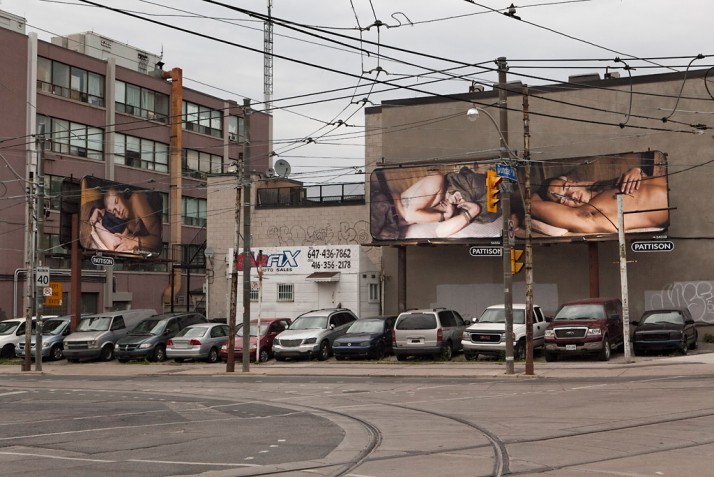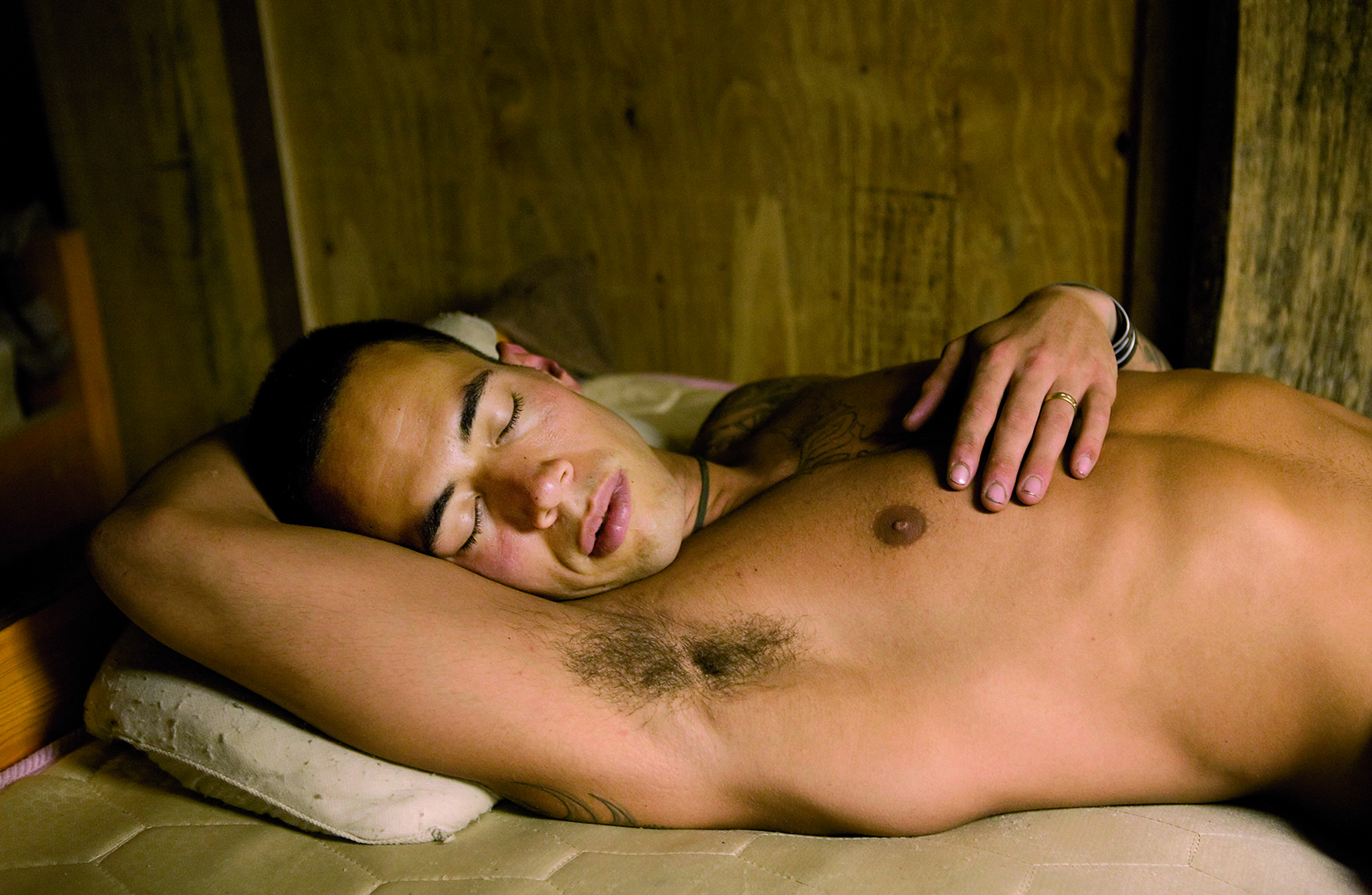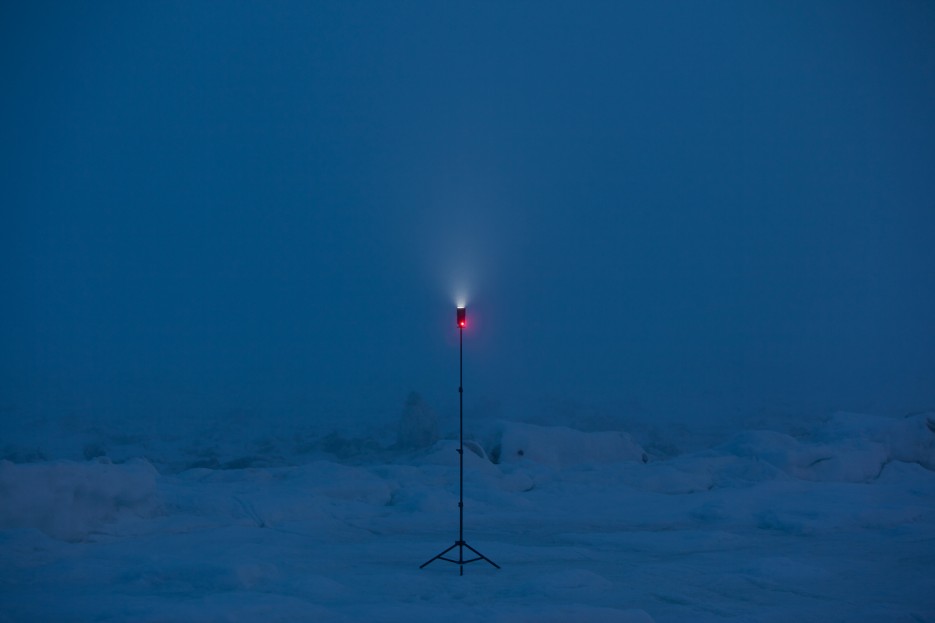At Hotdocs this past week I had the opportunity to attend a screening of Sebastian Junger’s moving cinematic portrait of war photographer, fellow filmmaker and friend Tim Hetherington, “Which Way is the Front Line from Here? The Life and Time of Tim Hetherington”. On April 20, 2011 Hetherington died as a result of shrapnel wounds sustained while covering the civil war in Libya. Junger’s documentary moves carefully towards this coda, underlining the hazards and preoccupations for those who work on the front lines of conflict, not the least of which is the addictive pull of war. Along the way we get a sense of Hetherington’s developing visual sensibility, from his early work documenting rebel soldiers during the 2003 battle for Monrovia, to his more recent film and photography projects chronicling the experiences of US Airborne soldiers stationed in the Korengal Valley, Afghanistan. Junger’s documentary incorporates plenty of candid moments with Hetherington, who communicates his thoughts sometimes awkwardly, often humorously but always with passion and cadence. We learn about his life on the front lines as told from the sidelines, by those who loved him and those whom he loved, and by those journalists with whom he toiled in the field of combat. Lastly, we learn about how Hetherington spoke with the subjects of his work and how, through the lens of the camera, they spoke back to him and then to us.
Watching the film I had the strange sensation of encountering Hetherington as if I were seeing him through the viewfinder of the medium format camera that he favored: by looking indirectly, Junger is able to mirror and transpose moments of Hetherington’s life into a visual narrative alive with intimacy and depth – much like Hetherington’s own photographic images. As a war photographer, Hetherington was fascinated with the emotional costs and human consequences of conflict. He saw these facets not in the subjective violence of combat – bodies maimed and lives destroyed – but rather as magnified through the minor details and discarded content of war. One image, for example, from his Korengal series, Infidel (2010), depicts the interior of the platoon’s makeshift cut-out latrine; raw plywood, plastic and remnants of filth convey the quotidian yet abject character of war while summoning a horrifying association with what else (besides human waste) might get burned on the battlefield. Hetherington’s proclivity is to avoid the didactic representation of war, preferring instead to limn the symbolic and systemic violences that underlie it. A constant theme throughout his work, Hetherington zeros in on the social performance of masculinity in times of conflict, seeking to explore the relations of love and of hatred that bind men together in combat.
 Tim Heatherington, Sleeping Soldiers (2008), Billboards from Toronto’s 2012 Scotiabank Contact Photography Festival.
Tim Heatherington, Sleeping Soldiers (2008), Billboards from Toronto’s 2012 Scotiabank Contact Photography Festival.Junger’s documentary altered my perspective on Hetherington’s work in Infidel. The publication, which brings together a collection of images shot by Hetherington over the course of approximately one year (2007-2008), records the experiences of the Second Platoon of the 173rd US Airborne Infantry Brigade stationed at forward operating base Restrepo in the north east of Afghanistan. Lauded for his efforts documenting the daily exploits of soldiers in a setting noted for its intensity of combat, Hetherington was awarded the 2007 World Press Photo of the Year. Images from his “Sleeping Soldiers” series were featured on public billboards as part of Toronto’s 2012 Contact Photography Festival (fig 1). Commenting on his impulse to photograph members of the platoon sprawled asleep in their bunks – what he saw as a rare moment of vulnerability – Hetherington had this to say: “You never see them like this…They always look so tough, but when they’re asleep they look like little boys. They look the way their mother’s remember them”.1 I want to think about this statement in relation to several images from Hetherington’s series: “Aleantara Sleeping” (fig 2) and “Kelso Sleeping” (fig 3). Before doing so however, I first situate this conversation within a broader discussion about the relation between art, pedagogy and desire, themes that I intend to explore throughout this series of visual investigations under the title of Wanting Images.
If one could interview all the pictures one encounters in a year, what answers would they give?2
“What”, asks W.J.T. Mitchell in his oft-cited query, “do pictures really want?”3 With this curious phrasing, Mitchell frames his exploration of how images work in visual culture as a question of desire. While we might typically think of desire as an appetite arising from the artist or viewer, Mitchell positions the visual image as wanting something for itself. This might seem implausible at first – pictures, after all, cannot claim personhood. But Mitchell’s point with this phrasing, I think, is to turn our attention to the question of how images stand up against the “social field of human visuality” through which we perceive.4 To position the image as something that wants and therefore claims subjectivity is not so much a literal truth, as it is a symptom of how one has learned to look (or, just as importantly, to overlook). But how to interpret the symptom that Mitchell’s query reveals?
Curation might be one response to this question. Here, I am thinking with O’Neill and Wilson’s understanding of contemporary curation as emphasizing “the framing and mediation of art and the circulation of ideas around art, rather than (…) its production and display.”5 This orientation resists the authorial position of the curator or artist (Mitchell’s query, after all, is not concerned with what they might want) in favor of a model of curation as a cultural practice of interpretation that recruits and circulates ideas and perhaps, even desire. “What pictures want”, he claims, “is not the same as the message they communicate or the effect they produce; it’s not even the same as what they say they want. Like people, pictures don’t know what they want; they have to be helped to recollect it through a dialogue with others.”6 Is this dialogue then curation? While I don’t have a definitive answer here, I am curious to explore what it means to shift our relations of looking from an analysis of power (how aesthetic objects are produced and circulated) to desire (how aesthetic objects raise the search for satisfaction as a question of seeing). Can images educate us to our own desires? Perhaps the answer to this question is the question of what the image really wants.
What the picture awakens our desire to see, as Lacan might put it, is exactly what it cannot show. This impotence is what gives it whatever specific power it has.7
 Tim Heatherington, Aleantara Sleeping (2008).
Tim Heatherington, Aleantara Sleeping (2008).Mitchell’s provocative description of desire is that which is lacking and therefore in constant search of itself. By raising the question of what the image wants (itself unanswerable), Mitchell draws our attention to how the image creates a cause that brings desire into being. Bruce Fink, in his helpful interpretation of the Lacanian perspective, puts it thus: “Desire, strictly speaking, has no object…It does not seek satisfaction, but rather its own continuation and furtherance: more desire, greater desire! It wishes merely to go on desiring.”8 Thus, the pedagogical force of Mitchell’s question comes not from the correct answer (or any answer for that matter) but rather with the urge to go on asking. The following quote sums up his thinking well:
What pictures want, then, is not to be interpreted, decoded, worshiped, smashed, exposed, demystified, or to enthrall their beholders…What pictures want in the last instance, then, is simply to be asked what they want, with the understanding that the answer may well be, nothing at all.9
Where there is nothing, there is lack; and where there is lack, desire has room to reach. If, in an encounter with an image, one is too easily satisfied by its’ answer, then perhaps it seems reasonable to say that the image has failed to arouse. If, on the other hand, the image resists questioning without too much frustration, then desire is kindled. While some frustration is key to sustaining relationality, how much is too much? Returning now to my discussion of Hetherington’s work with this framing in mind, I am able to raise several questions: does the “Sleeping Soldiers” series provoke us to go on asking? What questions might one ask? If one were, as Mitchell suggests, to “interview” the images, what answers would they give? Let us look first to the images and then consider the public billboard project.
 Tim Heatherington, Kelso Sleeping (2008).
Tim Heatherington, Kelso Sleeping (2008).
The images of Aleantara and Kelso are tightly composed, their bodies extending beyond the photographic frame, a strategy that conveys a sense of intimacy also implied by the sleeping posture: Aleantara’s arm is flung behind his head, exposing the armpit (a vulnerable location on the body for any soldier) whereas Kelso, legs drawn up, hand between his knees, resembles a sleeping child. This association was no doubt evident to Hetherington who, as revealed by his commentary, was struck by the seeming dichotomy between the child of sleep life and the man of wake time. “They look”, he muses, “the way their mother’s remember them.” While I have trouble with this phantasy for its easy split between adult masculinity and boyhood innocence, a disturbing view given the social actualities of the war (sleeping soundly in military barracks implies at least some degree of structural safety as opposed to vulnerability; soldiering depends on gender performances in which certain forms of vulnerability are categorically denied, itself a social violence; the fact that many militia fighters in the Afghan conflict are of an age those in the west would consider to be youth), interesting questions about the relations of precarity in times of war are raised. For example, Judith Butler draws our attention to the ways in which war mimimizes precarity for some (the soldier) and maximizes it in others (the “enemy”) thereby denying the “ongoing and irrefutable ways in which we are all subject to another, vulnerable to destruction by the other”.11 This idea that the soldier’s vulnerability is somehow a surprise (as if we have all bought into the heroic or, on the other hand, the demonic myth of the soldier) is echoed in the public billboard project organized by Contact Photography Festival as a memorial gesture to Hetherington’s life. We see this in the following excerpt from the curatorial statement: “Shown on billboards across the country, Hetherington’s soldiers evoke the idea of tactical vulnerability. By implication, the project starts a conversation about Canada’s role in foreign military conflicts—and how such engagements effect those who participate on our behalf.”12 The ways in which state sponsored violence nurtures and exploits masculine (and some feminine) bodies in the service of what Dina Georgis calls the domestic labour of the nation13, is certainly worth thinking about. But the interpretations that I have just outlined are really more related to the kind of interpretive practice that is concerned with what either the artist or the curator wants. What do the images want? How does Mitchell’s enigmatic question reorient our encounter with these images, if at all?
I end this blog entry by posing several questions raised by my thinking with Mitchell thus far. I consider these queries a jumping off point for further entries in the Wanting Images series. What does the image want from the viewer and how do we resist and/or comply? With regard to Hetherington’s “Sleeping Soldier” series, how are the subjects of war constructed in time and space and who are we in relation to them? Is the project pedagogical and which lessons of war does it teach? Approaching the images as a question rather than an answer might shift the position of the viewer as the subject presumed to know to the one who desires.
1. Tim Hetherington. Infidel. (New York: Chris Boot Ltd., 2010), 15.↩
2. W.J.T. Mitchell. What Do Pictures “Really” Want? October, 77. (Summer, 1996), 76↩
3. W.J.T. Mitchell. What Do Pictures “Really” Want? October, 77. (Summer, 1996), 71-82. ↩
4. Mitchell, 81↩
5. Paul O’Neill and Mick Wilson (eds). Curating and the Educational Turn. (London: Open Editions, De Appel Arts Centre., 2010), 19↩
6. Mitchell, 81.↩
7. Mitchell.78↩
8. Bruce Fink. The Lacanian Subject: Between Language and Jouissance. (New Jersey: Princeton University Press, 1995), 90.↩
9. Mitchell, 82. ↩
10. Hetherington, 15.↩
11. Judith Butler, Frames of War:When is Life Grievable? (London:Verso, 2009), 43, 54.↩
12. http://2012.scotiabankcontactphoto.com/public-installations/979↩
13. Dina Georgis, Masculinities and the Aesthetics of Love: Reading Terrorism in De Niro’s Game and Paradise Now. Studies in Gender and Sexuality 12:2 (2011), 134-148.↩

